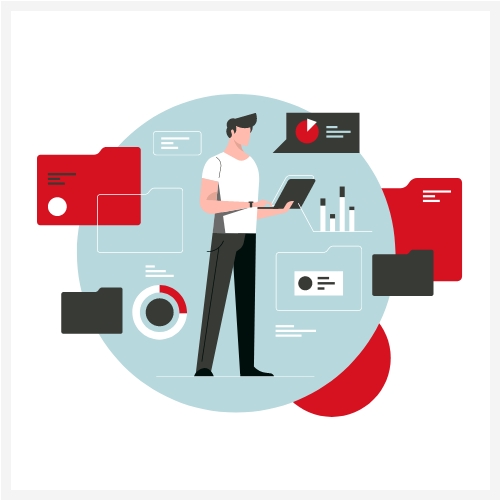Even before the pandemic, remote jobs were a growing workplace trend. Virtual assistants were on the rise, medical coders made good money from home, and accounting firms could oversee their clients’ books by logging in online, without ever leaving the office.
Today, the demand for remote work is higher than ever. But there’s a big difference between “remote work” and the kind of streamlined, distributed workforce that can scale competitively.
If you’re considering more permanent work-from-home (or hybrid) options for your team, it’s important to understand the difference between remote and distributed workplace trends—and how midsize businesses are using the latter to outpace the competition.
What’s the difference between remote work and a distributed work environment?
The term “remote” work simply means that people can work, well, remotely. This is synonymous with the term “work from home.”
At first blush, the term “distributed work environment” sounds like it’s the same thing. People can work together despite being distributed across different locations.
But there are two main differences between these terms that change everything.
The first of these lies in the mentality behind them. During pandemic lockdowns, many companies were forced to let their employees do their jobs at home. It was either that, or not do them at all. Companies didn’t want to do it. They had to do it.
For many of these—including a surprising number of tech companies—the idea of a “normal” work environment never changed. People working at home were seen as having to “make do,” and their teams, or at least their managers, couldn’t wait for health precautions to be lifted so everyone could “get back to normal.”
Other companies, however, weren’t satisfied by making do. They wanted to figure out how to turn this new circumstance into a competitive advantage.
Instead of trying to do their jobs in the same way at home, they created truly distributed teams—groups that could work together better than they had in the office, using technologies designed specifically for distant collaboration.
For those companies, distributed teams are more than the new norm. They’re the future. They’re streamlined, efficient, and highly effective. Better yet, they’re scalable, which is the other major difference between “remote” work and a “distributed work environment.”
Distributed work environments are poised for rapid growth.
What are the advantages of a distributed work environment?
Because a distributed work environment is designed to let people work from anywhere, it takes advantage of another key workplace trend—the tendency among top Gen Z and Millennial talent to prioritize flexible, remote work arrangements.
In fact, these tech-savvy individuals are
From a financial perspective, a distributed work environment also reduces the tremendous overhead of maintaining a physical office. By letting go of those spaces, telework saves these companies an average of $10,000 per employee per year in real-estate costs alone.
But it’s important not to downplay the challenges of moving to a distributed work environment. Beyond the mental shift—which can be a significant obstacle—many companies are mired in paper-based back-office operations, making any move away from a centralized office feel overwhelming if not impossible.
From filing systems to check payments that require physical approvals and signatures, companies need to escape their paper shackles if they want to step into more streamlined, distributed operations.
Using cloud-based technology to make the transition
With the prevalence of tools like Zoom, Slack, and Google Workspace, distant communication is fairly easy to achieve. Cloud-based documents have largely replaced printed memos, and cloud-based video recordings let people “attend” meetings hours or even days later.
But what about back-office operations? Fortunately, modern back-office systems are primed for cloud-based distribution—popular systems that most midsize businesses are already using.
For example, many business accounting systems are based in the cloud, and the tools that integrate with those systems are specifically designed to help back-office operations transition into a digital, distributed environment.
By adding cloud-based tools like Bill.com—designed to digitize, automate, and streamline AP workflows—companies can transition their back-office operations into fully distributed systems that are much faster and more efficient than their paper-based counterparts.
Using automation to scale the advantage
Another major advantage to embracing cloud-based, distributed systems is the potential to add automation for mundane, routine tasks.
Invoice approvals, for example, follow strict rules as to who needs to approve what—according to specific vendors, departments, threshold amounts, etc.
Automation can route those approvals to the right people, saving human beings the time of distributing approval requests, following up by email, collecting the approvals, and storing them. Approvals can be collected and stored digitally, in a time-stamped audit trail, with different levels of visibility depending on a user’s role in the system.
Invoices themselves can be entered automatically and displayed for review rather than depending on human beings to type them in by hand. With the right system integrations, that single invoice entry can flow through the process of approval and payment and even sync with accounting software, eliminating the need (and potential human error) of manual double entry.
How to implement a distributed work environment for AP professionals
If you want to take advantage of a fully distributed work environment, it’s important to transition any paper-based systems to cloud-based systems. Otherwise, you’ll end up with a team of disconnected, remote workers who are still relying on paper and struggling to work in the same old way.
Fortunately, paper-based, back-office systems can be migrated to an integrated, cloud-based tech stack no matter what your current situation is—whether your team is still in a physical office or already working from home.
To learn more about cloud-based, back-office systems and automated AP, read these next:





